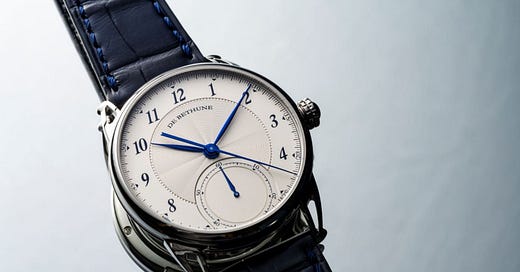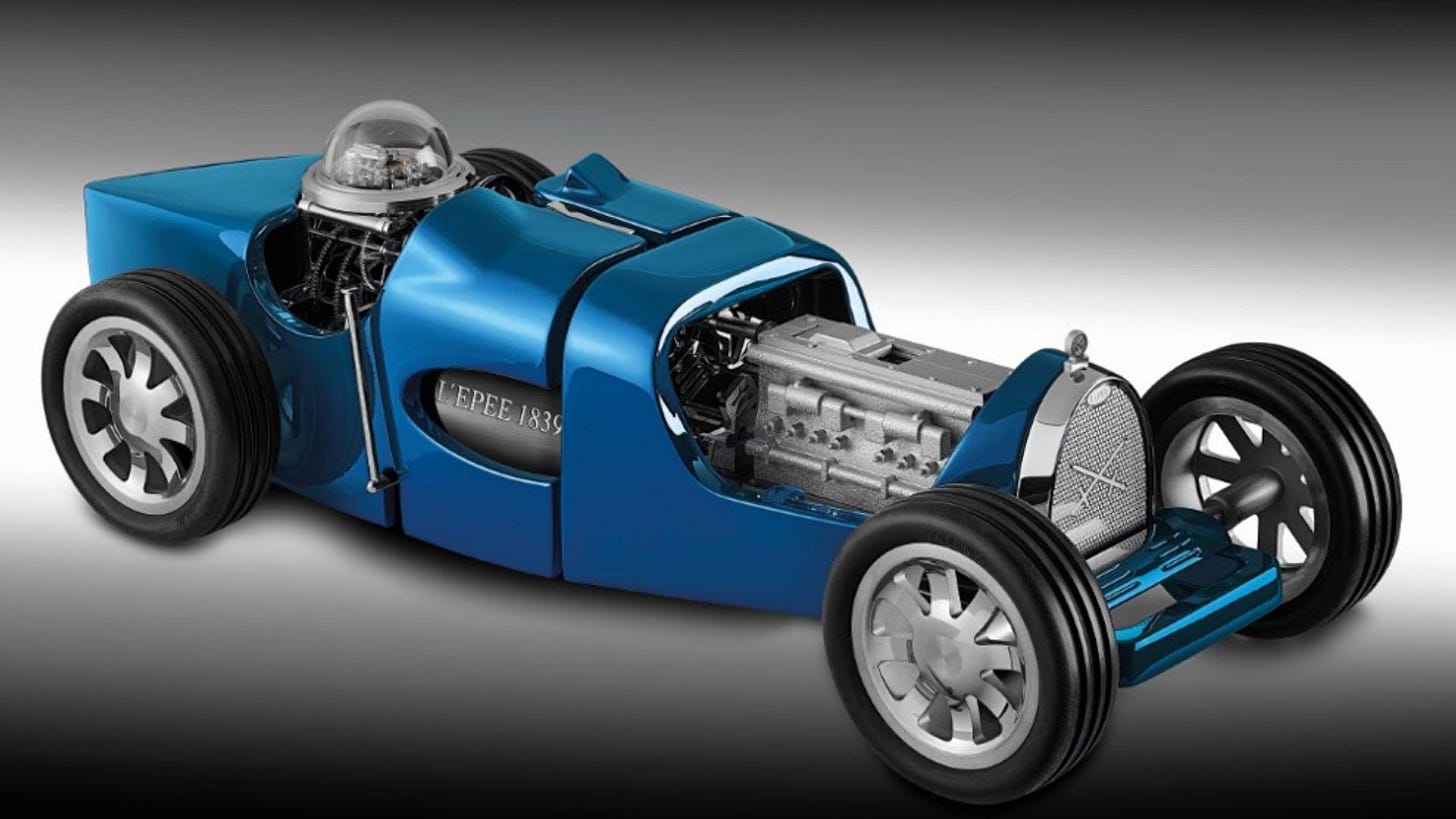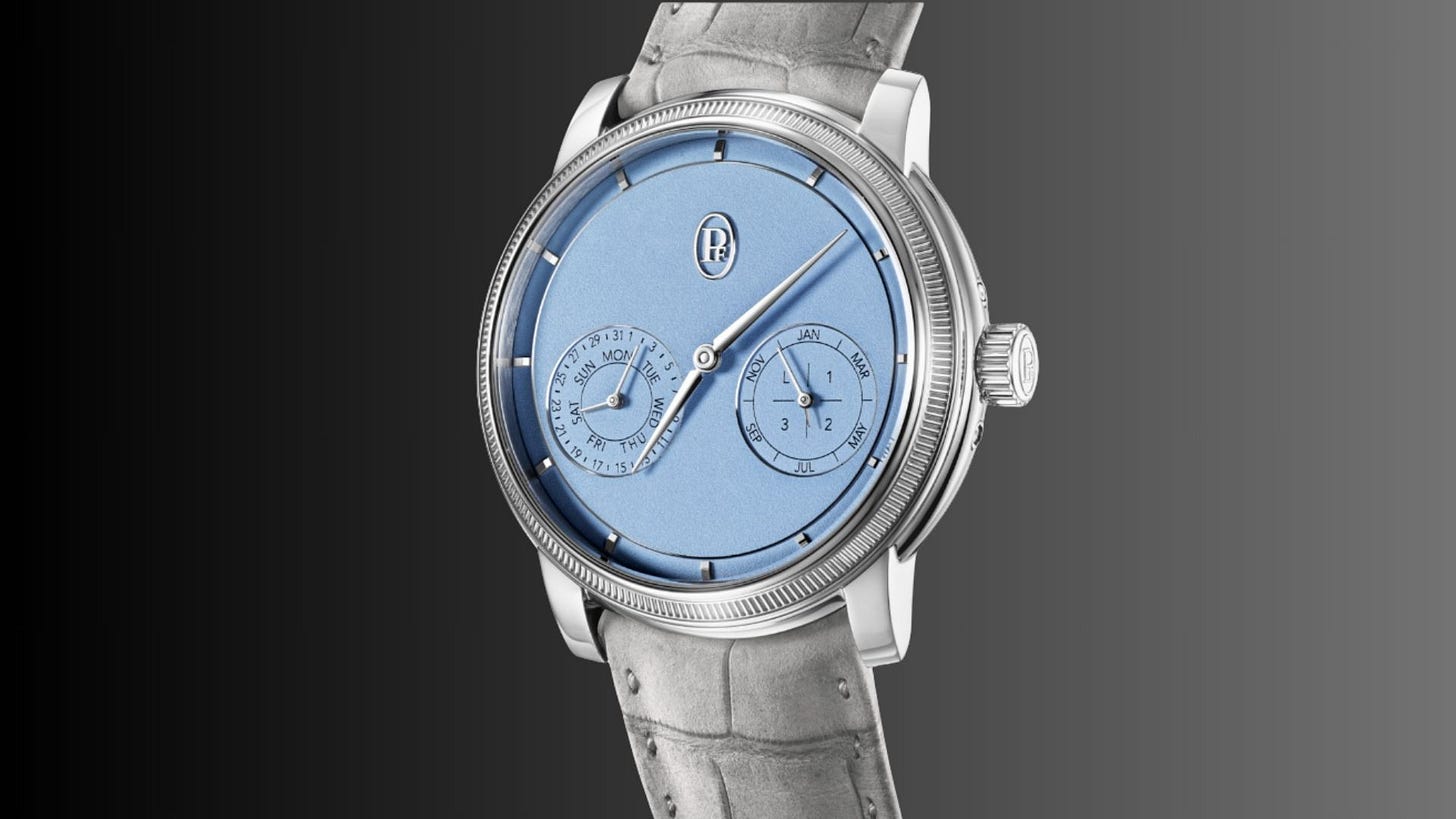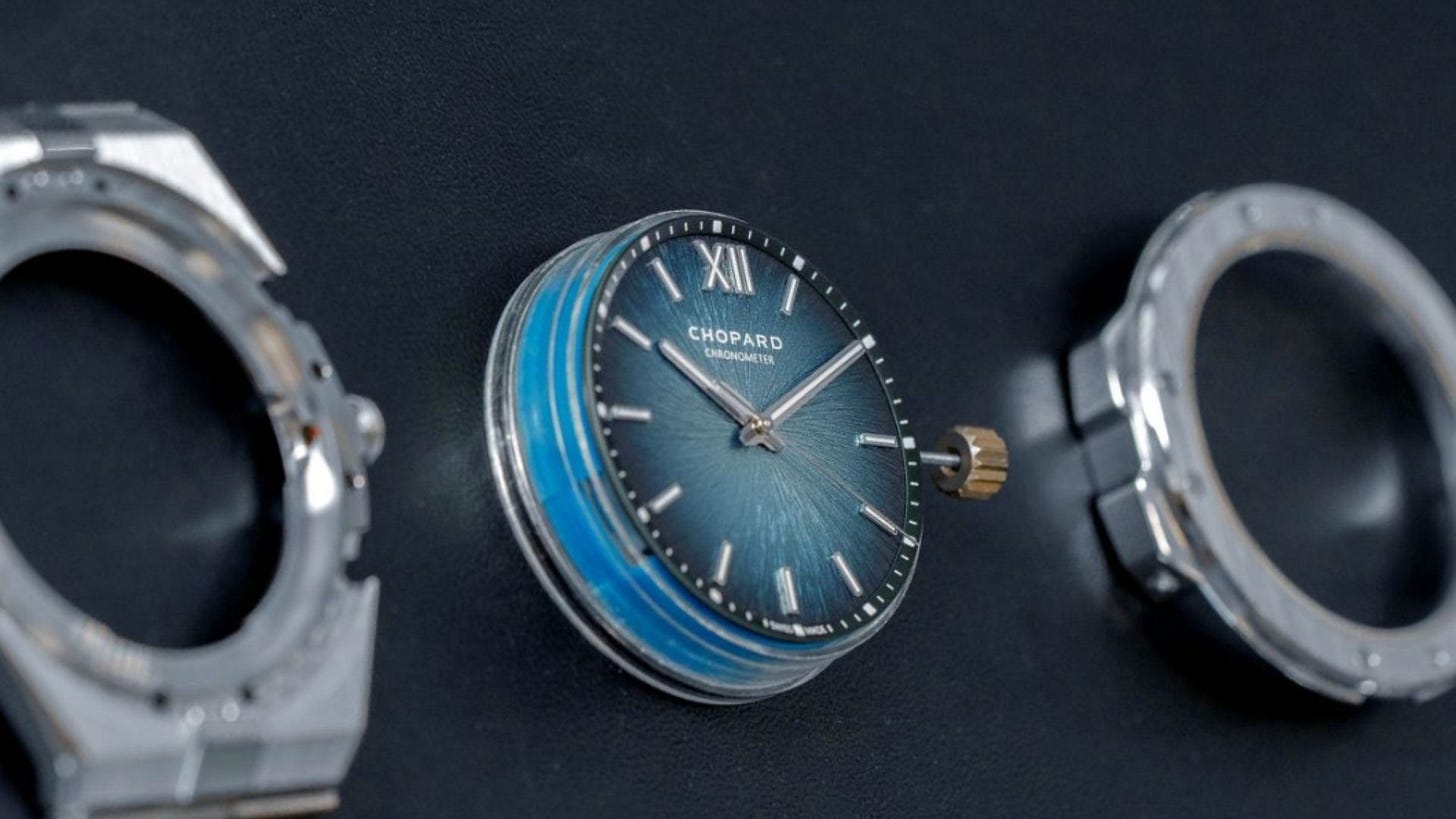L’Épée Dreams Big, Platinum Shines Bright, and Small Seconds Steal the Show
This week on WorldTempus: L’Épée 1839 brings fantasy to life, platinum dominates haute horlogerie, small seconds lead design trends, and earthy tones define quiet luxury.
THIS WEEK’S NEWS
De Bethune and the New Frontiers of Chronometry
Spring 2025 in Sainte-Croix. At the heart of De Bethune’s atelier, Denis Flageollet introduces the DB8 XS monopusher chronograph—a contemporary interpretation of a complication deeply embedded in the brand’s DNA. Presented in a newly compact 40 mm case, this timepiece reflects Flageollet’s relentless pursuit of precision. But for him, accuracy extends far beyond industry benchmarks. “Standards and certifications are limited to the analysis of 5 to 7 fixed positions. Yet today’s technology could allow for so much more. Standards serve the industry. But for those who want to go further, they become constraints.”
This philosophy has shaped De Bethune’s direction for decades. Recalling the DB25T Regulator Tourbillon launched in 2011, Flageollet highlights how its 30-second, high-frequency tourbillon—more stable and accurate than the norm—was deemed ineligible for a chronometry competition, as it did not conform to the one-minute rotation requirement. An episode that underscores his drive to innovate outside rigid frameworks.
At the end of 2022, De Bethune initiated the Sensorial Chronometry Project, a bold effort to personalize precision. A prototype worn for two weeks records over two million data points per hour. This granular information allows for adjustments tailored precisely to the wearer’s habits—far removed from theoretical averages. The outcome: a bespoke timepiece delivered with a detailed calibration report. Due to the complexity of the process, only five such watches can be created each year.
Another challenge lies in the balance spring—a key component for time regulation. “All suppliers produce the same type of balance springs. At the moment, it's very difficult to alter their thickness by even a few microns. But I want to test other cross-sections,” Flageollet states. To meet this goal, De Bethune is now developing its own production methods, opening new paths in chronometric innovation and reaffirming its role as a pioneer in mechanical watchmaking.
Horological Fantasies Become Reality with L’Épée 1839
At the intersection of craftsmanship and imagination, L’Épée 1839 continues to redefine what a clock can be. Through five singular creations, the brand demonstrates that telling time is merely the starting point for mechanical storytelling.
Beginning with the Watch Box, this transparent case elevates the presentation of a timepiece to an art form. With in-house finishes and a self-winding internal mechanism activated by closing the lid, it is as complex as the watches it safeguards, displaying an intricate ballet of gears and levers beneath its surface.
For 2024, L’Épée 1839 brings mythology to the table—literally—with The Dragon. This sculptural table clock pays tribute to Chinese tradition through 88 limited pieces, each powered by the brand’s 1853 caliber. The movement, fully developed in-house, was shaped specifically to fit within the creature’s sinuous form, available in gold-plated, palladium-plated, or red lacquered variations.
Pushing artistic boundaries further, the Grenade x The Dial Artist collaboration transforms a military object into a vibrant kinetic sculpture. Each piece is unique, combining L’Épée’s mechanical savoir-faire with Chris Alexander’s signature colorwork. The timepiece is activated by pulling the pin, starting its 8-day movement and producing a steady ticking that echoes like a metronome of time itself.
In a striking partnership with MB&F, Albatross takes inspiration from Jules Verne’s universe. This 17 kg mechanical vessel houses two movements, three barrels, and 32 propellers. Its automaton component animates with each chime, while the chiming clock itself offers 8 days of power reserve—limited to just eight pieces per color.
Finally, the T35 marks the brand’s 185th anniversary with a race car-shaped clock. Echoing the design of 1930s vehicles, it is wound through the rear wheels and set via the steering wheel. The handbrake reveals a hidden flame under the hood, blending vintage automotive aesthetics with horological engineering.
Each of these creations reflects L’Épée 1839’s commitment to narrative-driven watchmaking, where time is only one part of the story.
WATCH KNOWLEDGE
No More Hands, Time for the Guichet!
Display windows, or guichets, are once again asserting their presence on the horological stage. Once considered a bold experiment in time display, these minimalist, graphic timepieces are being reinterpreted by contemporary watchmakers with striking creativity and technical precision. Originating as early as 1830, the guichet format dispenses with hands in favor of jumping numerals viewed through carefully placed apertures, offering a streamlined, architectural reading of time.
Cartier reintroduces its Tank à Guichets as part of the Privé collection. Nearly a century after its debut, this Art Deco icon returns in rose gold, yellow gold, and platinum. The latest iteration features two discreet openings: one for the jumping hour and another for the minutes. Powered by the manual-winding caliber 9755 MC, the design retains its 1928 minimalism with uncompromising precision.
Louis Vuitton’s Tambour Convergence, crafted in collaboration with La Fabrique du Temps, places the jumping hour at 12 o’clock above a sweeping minutes arc. The dial, set with 795 snow-set diamonds, transforms the watch into a luminous display of craftsmanship. The in-house LFMA01.01 caliber drives this piece, housed in a platinum case and priced at CHF 61,000.
Bremont breaks new ground with the Terra Nova Jumping Hour, featuring a bronze dial and a compass-inspired small seconds. The newly developed BC634 caliber delivers precise disc transitions, pushing the brand into new mechanical territory. Limited to 100 pieces.
Jaeger-LeCoultre’s Reverso Tribute Nonantième celebrates 90 years of Reverso with a dual-faced display. One side shows a traditional dial; the other reveals a jumping hour, trailing minutes, and a day-night indicator, all powered by the JLC 826 caliber in a rose gold Art Deco case.
De Bethune’s DB28 Digitale combines avant-garde design with horological innovation. An analog hour window, rotating minute disc, and a sculptural moon phase are encased in polished titanium, animated by the DB2144 caliber with a five-day reserve.
Finally, IWC honors history with the Tribute to Pallweber, drawing from an 1884 pocket watch. Its dual-window time display and lacquered dial evoke enamel charm, while the 94200 movement ensures synchronous disc jumps—blending heritage with modern engineering.
These six models show that the guichet is not merely a display technique—it is a bold statement of form and function, revisiting history with modern relevance.
2025 – The Year of Platinum?
This spring, platinum has emerged as the material of choice for discerning collectors seeking refinement without ostentation. At Watches & Wonders 2025, major brands including Rolex, Patek Philippe, Chopard, A. Lange & Söhne, Vacheron Constantin, and Parmigiani Fleurier have turned to this rare, complex metal to showcase their latest novelties.
Platinum, with atomic number 78, is among the rarest precious metals—15 to 20 times rarer than gold—and about 20% heavier. Its muted grey-white tone, subtly different from white gold or stainless steel, appeals to those who value understatement. But distinguishing it by sight alone can be difficult. Polishing techniques continue to evolve, with maisons achieving ever more refined finishes. Still, trained collectors often rely on hallmarks like the “950” stamp or hidden brand-specific symbols—such as the bee engraved on Chopard’s Alpine Eagle, or the ice-blue dial found on select Rolex models.
Despite its appeal, platinum poses significant technical challenges. It is softer than gold and scratches more easily, yet its density and resistance to oxidation make it ideal for long-term durability. “Platinum is a noble material known for its inalterable nature, but is also very delicate to obtain a perfect polishing,” explained Ferdinand Berthoud’s Vincent Lapaire when unveiling the new FB 3 in platinum. Patek Philippe also acknowledged the difficulties in working with this metal: “Tools become worn faster on platinum because of its abrasiveness and stickiness. We use three times as many tools to manufacture, assemble and finish a platinum case compared with gold.”
The growing interest in platinum is reflected in Swiss export data, where precious metal timepieces rose from CHF 9.36 to 9.67 billion between 2023 and 2024. Notable 2025 releases include the Patek Philippe Calatrava ref. 6196P, Parmigiani’s Toric Quantième Perpetuel Platinum Morning Blue, and the reissued Cartier Tank à Guichets. As techniques advance and demand rises, platinum continues to assert its place as a material of distinction in contemporary haute horlogerie.
Desert, Anyone?
Soft earth tones are taking center stage in watch design, with beige, sand, and warm browns dominating dials at Watches and Wonders 2025. Brands including Rolex, Hermès, Chronoswiss, Oris, Patek Philippe, Audemars Piguet, and Nomos are embracing this understated aesthetic, reflecting a broader cultural movement toward quiet luxury and nature-inspired minimalism.
Interior color expert Sara Garanty, who attended the Salone del Mobile in Milan, noted the widespread presence of hues aligned with Pantone’s color of the year, Mocha Mousse. She linked the growing popularity of “silky soft, earthy tones” in both fashion and horology to the pursuit of calm in turbulent times. “When nobody knows what will happen, we seek out the calmer tones like creamy beige, terracotta, and desert in order to find a calm within ourselves,” she explained.
Hermès captured this mood with the Arceau Le Temps Suspendu in a rich desert brown. Audemars Piguet introduced a new 18-karat alloy called sand gold for its Code 11.59 Selfwinding Flying Tourbillon—described as a metal that “hovers between white and pink gold and plays with the light.” Meanwhile, Rolex, Oris, Nomos, and Chronoswiss leaned into desert-themed naming and finishes, as seen in the Rolex Oyster Perpetual beige, Oris Big Crown brown, Nomos Club Sport Neomatik Worldtimer Dune, and the laser-engraved Chronoswiss Small Second Desert.
Garanty also connected this trend to a broader desire for handmade materials and tactile authenticity, a response to what she called “AI-fatigue.” She observed that trends today evolve rapidly, shifting every six months rather than every few years. As a result, watches are no longer lagging behind—they are reflecting cultural shifts in real time. The move toward muted, nature-based colors reveals a collective longing for simplicity, grounding, and a return to the essentials.
WATCH REVIEW
David and Goliath
At Watches and Wonders 2025, Chopard delivered a study in contrasts with two new Alpine Eagle models that redefine extremes in both weight and material innovation. These timepieces showcase the brand’s dual mastery of technical lightness and precious density.
Leading the lightweight category is the Alpine Eagle 41 SL Cadence 8HF, one of the lightest automatic watches on the market. Weighing just 75 grams including the strap—and 48 grams without—it is priced at CHF 23,000 and limited to 250 pieces. Its 41 mm case is crafted from ceramized titanium, a material developed for aerospace and automotive industries. The metal undergoes an electro-plasma oxidation process, creating a micro-blasted surface with a hardness of 1000 Vickers, offering resistance on par with ceramic. Inside, the in-house high-frequency caliber 01.14C beats at an impressive pace and features bridges and a base plate also made from ceramized titanium. Chronometer-certified, it reflects both performance and innovation in a minimalist design.
At the opposite end stands the Alpine Eagle 41 XP CS Platinum, which surpasses 300 grams with its platinum bracelet. This heavyweight reflects Chopard’s commitment to refinement and exclusivity. Platinum is not only 30 times rarer than gold but significantly denser, requiring specialized tools and craftsmanship to work with. For the first time, Chopard introduces a hand-engraved bee hallmark on the case—a discrete identifier for its platinum creations. The watch houses the ultra-thin L.U.C 96.42-L automatic movement, complete with a platinum micro-rotor and Geneva Seal certification.
These two Alpine Eagle models exemplify the brand’s range: one showcasing cutting-edge lightness through material science, the other emphasizing enduring value through traditional excellence and precious metalwork. Both expand the narrative of what defines luxury in contemporary watchmaking.












